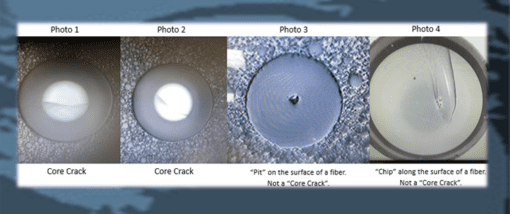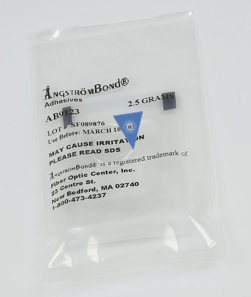Fabricating fiber optic cable assemblies is still in large part a manual process, requiring knowledge and skill. When something in the process goes awry, an investigation is needed to identify and address the cause. Recently, our team of experts met to discuss some frequent customer questions regarding Core Cracking in Multimode (62.5/125um) fiber.
We pooled our thoughts below, based on experience and discussions with our customers and other industry contacts, offering ideas to investigate various causes of core cracking. By better understanding this phenomenon, you can take preventive action to help ensure consistent process yields.
What Is Core Cracking?
"Core Cracking", as discussed here, is the phenomenon observed in 61.5/125um MM fiber, where a smooth, curved crack propagates across the core, but not the cladding, of the fiber. The crack is sub-surface and thus can be difficult to see without back-lighting the fiber during the inspection, which is always recommended practice. Without back-lighting, Core Cracks often appear as a faint dark curve in the core, and can easily be passed off by an operator as some random effect of the lighting in the inspection system, and not as a defect in the fiber. As you can see in Photos 1 and 2, back-lit Core Cracks are clearly identifiable as fiber defects.

Many types of cracks and other defects can occur on a fiber end-face. The Core Cracks we are talking about here are only visible within the core, extend fully across the core in a fairly smooth curved line, and are sub-surface. Pitting or chipping on the surface of a fiber end-face, though they may occur on the core of a fiber, are not "Core Cracks" (see Photos 3 and 4).
What causes core cracking?
Though we have not researched the details of the mechanics causing the core cracking, a (perhaps over-simplified) generalization that seems to hold is that the glass in the core of a MM optical fiber is more prone to cracking than the glass of the cladding. When stress is applied to the OD of the fiber, the core is subject to cracking. The larger the core and the larger the stress, the larger the chance of Core Cracking—which is why this phenomenon is almost always observed only in 62.5/125um Multimode fibers, as opposed to 50/125um or smaller.
During epoxy curing, stresses on the fiber from the epoxy curing process (elevated temperatures and material expansion/contraction) can be large enough to initiate cracks in the core material.
So….Epoxy is causing my Core Cracking?
Yes…..and no. It’s often the curing PROCESS that induces the cracking. The selection of appropriate epoxy designed specifically for Multimode cable assembly is obviously important. But even suitable epoxies can be cured using a wide range of curing temperatures. For reducing Core Crack potential, the lower the cure temperature, the better. For 62.5/125um fibers, it is recommended to cure at ~90 degrees C or lower. Curing above 90 degrees C, Core Crack frequency in 62.5um seems to increase. For example: if you are using an epoxy that can be fully cured at 80 C for 30 min, or 120 C for 5 min, you’ll reduce the potential for Core Cracking by using the “lower-and-slower” cure schedule.
In some cases, a production line may be building the same cable assembly successfully for some time, and then suddenly experience a sharp increase in Core Cracking—even though no change has been made to process. It is an understandable reaction to immediately suspect the epoxy is "bad"— perhaps a defective lot/quality error from the supplier. That is possible, but we have never seen a case where a defective epoxy lot was the cause. In all such situations, we have been involved with,
Core Cracking episodes are most often caused by curing at temperatures too high or using the wrong epoxy type for the application.
So what is the proper curing temperature profile?
In most cases, cable assembly manufacturers are curing by placing their room-temperature product into pre-heated curing ovens—quite a thermal shock. Based on our observations, it seems that curing in this manner, with an oven temperature below 90 degrees C will usually not produce Core Cracking. In many cases, epoxy manufacturers will provide a range of acceptable curing time and temperature combinations for a given epoxy—for example, the same epoxy may be able to fully cure in 30 min @ 80 degrees C, or 5 min @ 120 degrees C. To avoid Core Cracking, choose the lower temperature.
Some cable assembly houses have had good success by curing with a “ramped” temperature profile: where the room-temperature connectors are placed in a room-temperature oven, which is then gradually heated until the curing temperature is reached. This lessens the thermal shock to the product and may allow for curing at higher temperatures without Core Cracking. Curing with this method opens up the available range of epoxies available to use in your product, but does increase the curing time needed (ramp time + cure time), and can be more difficult to control.
Which epoxy is the best for my application?
Fiber Optic Center offers several epoxies for single-mode and multimode products. Refer to the "Chart of Epoxies for Single Fiber, Single Mode and Multimode Terminations" to review epoxy properties that will support your specific application.
There is a high degree of detail involved with every step of the epoxy process. While you may be using epoxy successfully in one particular application, don’t assume you can use the same epoxy and cure temperature in a different application. Carefully train your production team, and don’t take anything for granted.
Tips to investigate core cracking issues and identify the cause
We characterize epoxy-related core cracking as a phenomenon because this problem can occur infrequently and irregularly. If you experience this, you can investigate the possible causes and solutions in this article.
Single Fiber, Single Mode and Multimode terminations

VISIT our ÅngströmBond Solutions Center for additional epoxy expertise through:
- technical content, best practices, weekly tips
- our dedicated adhesives expert to help meet individual customer needs
- specialty stock materials or high-tech custom epoxies in custom package sizes
- FOC developed ÅngströmBond, the only specialty adhesive line developed exclusively for Fiber Optics

Our featured adhesive solution is the ÅngströmBond 9123 product:
- successfully passes GR-326 testing and Telcordia specifications
- low viscosity, rapid curing two-part epoxy adhesive
- recommended for single fiber, single-mode terminations
- if using a ramp cure schedule, is also an excellent choice for multi-mode terminations
- designed for bonding and potting optical connectors, fibers, lenses, prisms and other optical components
- high-strength, high Tg and exhibits lower fiber pistoning properties over other epoxies
- excellent temperature cycling capabilities
- withstands high humidity environments
Summing up the results of our investigation
We characterize “Core Cracking” as a phenomenon because this problem often occurs infrequently and irregularly. If you experience Core Cracking, take a good look at your curing temperatures and epoxy selection. We view this as an ongoing investigation, and we welcome your input. Contact us to discuss any core cracking, epoxy, or other process issues you may be facing. Together, we’ll investigate and look for a way to resolve the issue. Our goal is to help you make the best fiber optic cable assemblies in the world!
Additional resources from the FOC team include:
- View Epoxy Technical Solution Content
- View the Glossary, Acronyms, Military Specifications for Connectors
- Q&A Resource: email technical questions to AskFOC@focenter.com
- Bookmark the ÅngströmBond Solutions Center
- Featured Product Quick link: Featured Product: ÅngströmBond 9123




